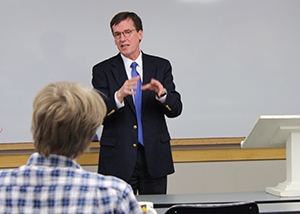Students in Prof. Denis Brennan’s class on Union College history won’t have
to wait until graduation to hear President Stephen Ainlay’s advice.
He imparted the essential elements of his annual charge to graduates during a visit on Monday to discuss the many Union alumni who made contributions to history, particularly during the Civil War era and the Lincoln administration.
“This is your history,” he told the class of 15 students. “It is your legacy and … there is an enormous responsibility that comes with that.”
He discussed a number of figures from Union’s history who made a difference in the Civil War era. Among them, William Seward (Class of 1820), secretary of state under Lincoln and the architect of emancipation; John Bigelow (1835), consul general to France during the Civil War who averted France’s involvement with the Confederacy; Chester Arthur (1848), who before he became the 21st U.S. president was quartermaster general responsible for raising thousands of troops for the Union; and Charles Elliott Pease (1856), who carried out the terms of surrender of Gen. Robert E. Lee.
“By choosing to come here [to Union] and walk in the footsteps of these kinds of people, you’ve made a decision that theirs is the kind of life you want to lead,” the president said.
Ainlay told the students that his charge to graduates each June echoes what Union’s first president, John Blair Smith, told classes at the end of the 18th century. “Whatever you choose to do … you have an obligation to figure out how you can make a difference.”
Students in Brennan’s class – Hidden in Plain Sight: Union College’s History and Treasures – are examining the historical relationship between the U.S. and Union College, and the distinctive historical elements that make contemporary Union a unique institution.
